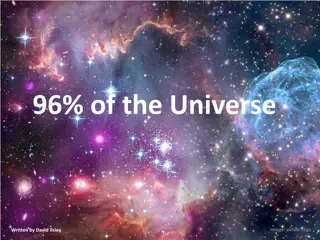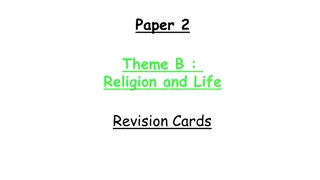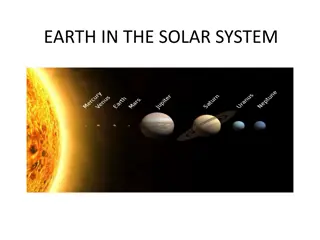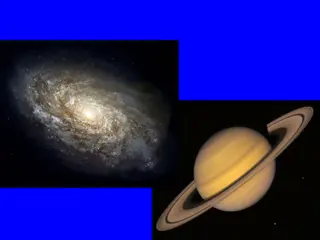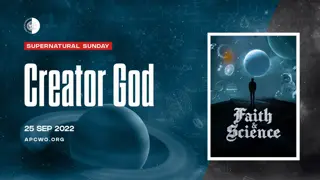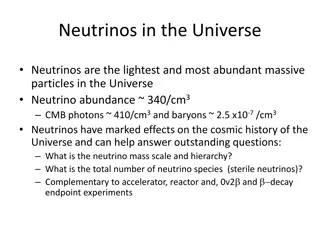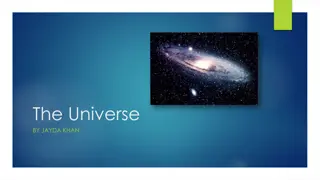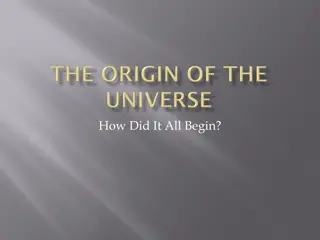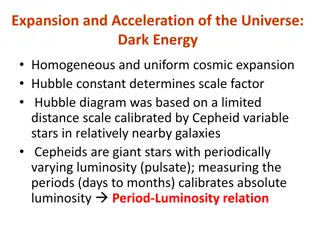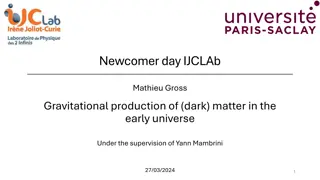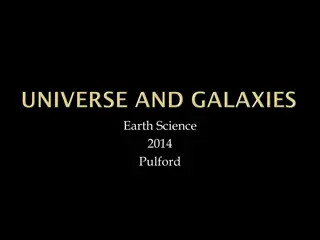An Exploration of the Vast Universe - Part 1
Delve into the intriguing magnitudes of celestial bodies and distances within our solar system, from the massive scale of the Sun to the minute size of Neptune in relation to the Earth. Discover the diversity of stars, planets, and dwarf bodies that populate our cosmic neighborhood, showcasing the immense wonders of the universe.
Download Presentation

Please find below an Image/Link to download the presentation.
The content on the website is provided AS IS for your information and personal use only. It may not be sold, licensed, or shared on other websites without obtaining consent from the author. Download presentation by click this link. If you encounter any issues during the download, it is possible that the publisher has removed the file from their server.
E N D
Presentation Transcript
Introduction to the Universe Part 1 Written by David Ilsley Image: commons.Wikimedia.org
The Earth is a fairly big place It takes 16 hours to fly from Alaska to Chile in a 747 going 900 km/h. It would take two years to walk it. Image: pixabay.com
The Earth is about 12 000 km in diameter. The distance to the Sun is 12 000 times as much as that 150 000 000 km. The Sun is 100 times the diameter of the Earth i.e. 1 200 000 km. This picture shows the Sun and the Earth to scale. How many Earths would fit inside the Sun? Image: flickr.com
A million Earths would fit inside the Sun. To fly around the Sun in a supersonic plane would take about 6 weeks. The sun is big! Image: commons.Wikimedia.org
And yet, astronomers classify the Sun as a dwarf. The universe is full of dwarfs. The sun is a yellow dwarf. There are white dwarfs, black dwarfs, red dwarfs and brown dwarfs. Image: flickr.com There are dwarf planets too like Pluto.
Image: commons.Wikimedia.org Here are some stars that we can see that aren t dwarfs. Betelgeuse is about 1000 times the diameter of the Sun. And, therefore, 1 billion times its volume.
But, back to the Sun. . . If the Earth were modelled by a 3 mm grain of sand, the sun would be the size of a basketball. Sun Earth Image: pixabay.com The sand grain would be 50 m from the basketball.
Neptune, the furthest planet from the Sun is 30 times as far away as the Earth. Image: en.wikipedia.org Neptune would be about the size of a marble 1.5 km from our basketball.
But Neptune is not the end of the solar system. Beyond that, there are dwarf planets and billions of comets as well as vast numbers of smaller bits of rock and dust. Image: pixabay.com The furthest comets are about 2000 times as far out as Neptune.
This is 1 light year from the Sun. So, the solar system has a radius of 1 light year. The Sun and planets occupy just a tiny speck of space in the centre of the solar system.
1 light year is the distance light travels in a year. Light travels 300 000 km per second. So, a light year is about 10 trillion kilometres or 10 000 000 000 000 km or 1013 km.
The nearest other star, Proxima Centauri, is 4 light years away. This is not much further than the outer limit of the solar system. Image: flickr.com But it s still 300 000 times as far away as the Sun. We can t see Proxima Centauri with the naked eye: it s a red dwarf and too dim.
4 light years is a typical spacing for stars in our galaxy, The Milky Way. The Milky way is a disk, with a bulge in the middle. The disk part has a diameter of about 100 000 light years and is about 3000 light years thick. Image: en.wikipedia.org
. Sun Image: flickr.com
Because the Earth rotates, we go around it at about 1400 km/h or 300 m/s The Earth goes around the sun at about 100 000 km/h or 30 km/s We go around the galaxy at about 7 000 000 km/h or 2000 km/s Even at that speed, it takes about 250 000 000 years to go round the galaxy once. So the dinosaurs lived on the other side of the galaxy.
The Milky Way contains about 400 billion stars. That s 400 000 000 000. Image: goodfreephotos.com Most of those stars are red dwarfs, a bit smaller than the Sun; some are very much bigger. As well as the stars, clouds of gas and dust make up about 5% of the galaxy.
Some clouds of gas and dust (nebulae) in our galaxy. Images: en.wikipedia.org, rawpixel.com,
The Milky Way is one of the bigger galaxies in the universe. It has about 50 smaller galaxies in orbit around it. The Large Magellanic Cloud and the Small Magellanic Cloud are two of these that can be seen easily with the naked eye. Images: commons.wikipedia.org
The nearest other large galaxy is the Andromeda Galaxy. This is a bit bigger than the Milky Way and is about 2 million light years away 20 times the diameter of the Milky Way. Images: flickr.com Travelling at 1 000 000 km/h, it would take 2 billion years to get there. That s about half the time the Earth has been in existence.
Actually, you might as well just wait, because Andromeda is heading towards us anyway. Andromeda and the Milky Way are going to collide. Images: flickr.com
Then they will swirl around each other for a while, eventually settling down to become a single larger galaxy. Here is an animation of the collision. https://www.youtube.com/watch?v=Jsqh-kNMxoM
Image: en.wikipedia.org Because galaxies are nearly all empty space, the two galaxies will pass through each other with probably not a single star collision.
The Milky Way and Andromeda, together with a few hundred smaller galaxies form the local group. The diameter of the group is about 10 million light years. Image: commons.Wikimedia.org
The local group is one of about 100 groups and clusters which make up the Virgo Super-cluster. The Virgo Super-cluster has a diameter of about 100 million light years and contains about 10 000 galaxies.
The Virgo Super-cluster is part of the even larger Laniakea Super-cluster which stretches across about 500 million light years and contains about 100 000 galaxies.
There are millions of other super-clusters in the observable universe. They contain about 2 trillion galaxies between them. These super-clusters form a network of filaments and walls with large super-clusters tending to occur where these meet. Image: en.wikipedia.org
There are bubble-shaped voids between the filaments and walls. These voids can be up to 200 million light years across. They give the universe a texture a bit like an aero bar. Image: flickr.com
On a larger scale, the universe is just a random repetition of voids, walls and filaments, going on for many billions of light years. At these sorts of scales, it is basically the same everywhere. We say it is homogeneous. Image: flickr.com
Introduction to the Universe Part 2 Written by David Ilsley Image: commons.Wikimedia.org
Seeing the past When we look through a telescope at a galaxy 1 billion light years away, we see it as it was 1 billion years ago. This is because the light that is reaching us now set off 1 billion years ago. Image: flickr.com When we look through a telescope at a galaxy 2 billion light years away, we see it as it was 2 billion years ago. And so on.
If we look at things far enough away, we can see them as they were over 13 billion years ago, soon after the big bang that happened 13.8 billion years ago. Image: flickr.com
Of course, it took a while for stars and galaxies to form after the big bang. The time before they formed is called the dark age of the universe. It was dark then. The dark age may have lasted 100 million years or so. So, we won t see any galaxies more than about 13.7 billion years old.
But there was light before the dark age. For the first million years, the universe was hot enough to glow visibly. That light would come from everywhere in the universe, so we should see it wherever we look. In fact, we do. It is the cosmic microwave background radiation. Image: commons.wikimedia.org
But before 380 000 years after the big bang, the universe was foggy because all atoms were ionized, and photons kept being absorbed and re-emitted in different directions. So, we will never see any further back than that. Except maybe using gravity waves instead of light. Even with gravity waves, though, we could only see back another 380 000 years, because beyond that, before the big bang, there was nothing to see.
So, we can only see things up to a certain distance. This defines the observable universe. The observable universe is a sphere centered on the Earth with a radius of 46 billion light years. Image: commons.wikimedia.org
The observable universe is 300 000 000 000 000 000 000 000 000 000 000 000 000 000 000 000 000 000 000 000 times as big as the Earth. This is 3 1059 It contains about 2 trillion galaxies.
Image: peakpx.com Now you may wonder how light from galaxies 46 billion light years away could have got to us in just 13.8 billion years.
This happens because the universe is expanding. Image: commons.wikimdia.org Those galaxies were much closer to us when the light set off, so the first part of the light s journey took place through a much more compressed universe. The universe has expanded behind the light photons.
The surface of the observable universe is called the cosmic horizon because we cannot see beyond it. There is nothing special at the cosmic horizon. A different galaxy would have its cosmic horizon in a different place from ours. There is no reason why anything should change at our cosmic horizon. The universe and galaxies would continue beyond the horizon. We just can t see them. Image: commons.wikimedia.org
It is possible that the universe goes on for ever. Even if it doesn t, there is reason to believe that it is at least a hundred billion trillion times as big as the observable universe. Either way, it s a big place.
Later, we will learn about the big bang and inflation which went with it. Inflation was a period of very fast expansion. It lasted 0.000 000 000 000 000 000 000 000 000 000 001 seconds (10 33 seconds). During that time the volume of the universe increased by a factor of 1078.
At the end of inflation, it was about the size of a grapefruit. So, it was very small before inflation. Image: maxpixel.net
It seems likely that the process of inflation would have produced numerous universes. There would be billions of such universes, though they wouldn t necessarily be anything like ours. Most probably wouldn t contain any atoms or matter. We might just be lucky that ours does. But then again, we couldn t exist in a universe without atoms, so the universe we live in had to be one of the lucky ones.
This collection of universes is called the multiverse. Image: commons.wikimedia.org
Image: rawpixel.com Who knows? There might be an infinite number of multiverses. We don t know why the universe or the multiverse exists. And we certainly don t know that only one of them exists.
The End Image: rawpixel.com




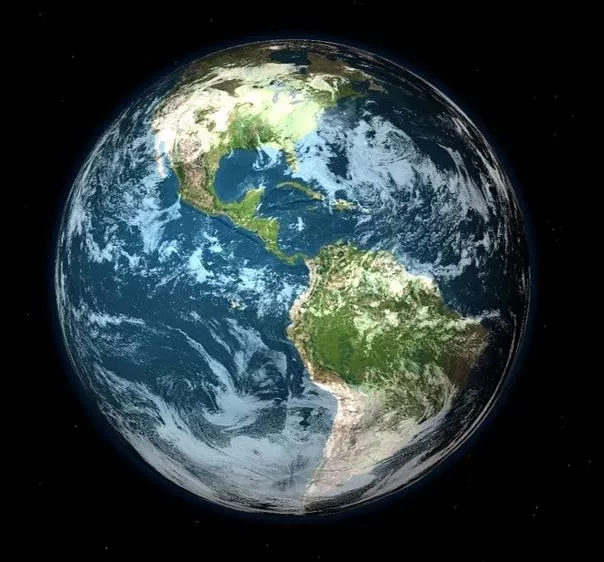


![textbook$ What Your Heart Needs for the Hard Days 52 Encouraging Truths to Hold On To [R.A.R]](/thumb/9838/textbook-what-your-heart-needs-for-the-hard-days-52-encouraging-truths-to-hold-on-to-r-a-r.jpg)
![Read⚡ebook✔[PDF] Life in the Universe: Expectations and Constraints (Springer P](/thumb/21626/read-ebook-pdf-life-in-the-universe-expectations-and-constraints-springer-p.jpg)

